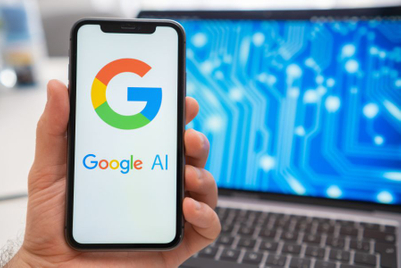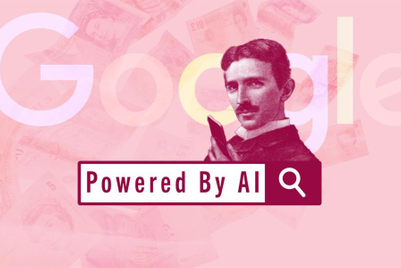
AI is already transforming advertising, delivering results through sophisticated analytics and predictive capabilities. From automated bidding to powerful campaign automation tools, it has been the engine driving efficiency and relevance behind the scenes. But now, with gen AI, we stand at the cusp of an even more profound transformation—one that demands marketers to actively embrace a new era of connected consumers.
Most advertisers have adopted AI, with more than 80% already using at least one AI-powered search Ads product. And it’s working: a study we did with BCG showed that marketers who have deeply integrated AI tools report 60% greater revenue growth than their peers.
But this is just the beginning. We’re seeing more opportunities for AI to bolster an already vibrant digital advertising business, and increasingly move at the speed of the consumer.
People’s time spent online is getting even more unpredictable and multi-modal. Taking a photo can now be searching. Scrolling can now happen on your TV in the living room with your remote. And you could also pause a creator video to circle something in the background – in other words, users can be streaming, scrolling, searching and shopping, all at once.
With this fluid behaviour, traditional, siloed marketing tactics need to keep up. Marketers can no longer afford to operate in isolated channels. Instead, they need to be reaching consumers across every possible moment of influence from discovery to decision. That means using the right platforms to reach people where they are—from researching a brand, to watching creator videos, checking maps on where to shop in a new city and more.
Showing up where it matters across video, search and visual discovery
We’re also in the midst of another shift of viewing behaviour—streaming in the living room. Around the world, people are watching billions of hours of YouTube content on connected TVs. This is a trend particularly pronounced in Asia. In most APAC countries, connected TV watchtimes have more than doubled in the past three to four years. In Taiwan, they have more than tripled.
Savvy advertisers recognise this and are building connected TV campaigns into their media strategies. They are seeing good results, especially with younger, action-oriented demographics. Kantar survey data indicates that young adults in South Korea are more likely to take action as a result of seeing connected TV ads compared to linear TV ads.
Next, the way people search is also changing. AI toold have led to users searching more and visiting a greater diversity of websites, creating more opportunities for brands to show up to customers, especially those with purchase intent.
Balancing AI and user privacy
However, this evolution of AI in marketing occurs alongside a critical and parallel development: the increasing focus on user privacy. As AI-powered tools help marketers keep pace with changing consumer behaviour and deliver relevant ads, it’s important to ensure people have transparency and control over the data used to inform their online experiences.
The balance between delivering personalised experiences through AI and upholding robust user privacy will be a defining challenge of this era. This is underscored by innovations like confidential matching, which integrates confidential computing, a privacy-enhancing technology, directly into tools to provide added security and transparency by default.
So, what should marketers focus on now?
First, reach consumers in the moments that matter. With consumer behaviour becoming more fluid, brands need integrated marketing strategies that mirror this journey. This means consistent brand presence at every touchpoint, from discovery to decision. This is where AI-powered tools can come in to ensure your ads appear on the right platform, when and where your audience is more receptive. And we’ve seen this impact first-hand.
By deploying AI-powered ads across Search, Google Shopping, and YouTube, L’oreal Thailand effectively reached and directed customers to their Shopee Mall stores for three of its brands. This cohesive strategy resulted in a 15% sales uplift, and a return of $5 for every $1 invested on ads, demonstrating the power of integrated marketing plans.
Secondly, piroritise video as a core element of your outreach. SEA’s YouTube users drive 20% of all video consumption globally, and 8 in 10 users in Southeast Asia watch online video daily. This active video consumption presents a powerful opportunity for brands to connect with audiences in engaging ways.
We’ve seen brands like Agoda taking it a step further by using AI to generate more than 1,000 creative assets in seven languages. This enabled them to deliver highly relevant content at scale to meet the various motivations of travellers, and converted this discovery to action by driving clicks to the Agoda app and website. Features like YouTube Shopping also now allow brands to launch creator-led marketing campaigns by enabling viewers to directly purchase from videos, shorts, and livestreams on the platform using embedded links.
Third, turn measurement from a lookback tool to a predictive one. AI is key to keeping pace with your customers—adjusting your strategy in real-time, and helping transform measurement from a retrospective tool to a predictive engine for growth. But AI is only as good as the data that fuels it, so quality first-party data is essential to building a reliable, accurate foundation. Implementing a mix of tools like attribution, media mix modeling and incrementality testing will also enable you to move at the speed of your customers and draw a straight line from your marketing efforts to the bottom line.
Lastly, drive AI momentum across the company. The rapid pace of AI development necessitates a proactive mindset. Encourage your teams to explore new AI tools and functionalities, as this commitment to adaptation is crucial for maintaining a competitive edge.
AI is not a trend, it’s a competitive advantage. Those who proactively adapt, strategically integrate AI, and relentlessly prioritise user trust will not just navigate this new reality, but will seize the immense opportunities it presents. So the question is not whether you can afford to embrace AI, but whether you can afford not to.
Ben King is managing director, Google Singapore & APAC Agency



+(900+x+600+px)+(3).png&h=334&w=500&q=100&v=20250320&c=1)
+(900+x+600+px).jpg&h=334&w=500&q=100&v=20250320&c=1)
.jpg&h=334&w=500&q=100&v=20250320&c=1)


.jpg&h=334&w=500&q=100&v=20250320&c=1)
+(900+x+600+px).png&h=334&w=500&q=100&v=20250320&c=1)

+(900+x+600+px)+(1).png&h=334&w=500&q=100&v=20250320&c=1)

.jpg&h=268&w=401&q=100&v=20250320&c=1)






.jpg&h=268&w=401&q=100&v=20250320&c=1)